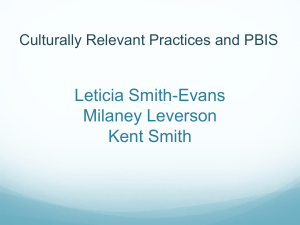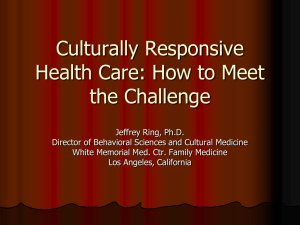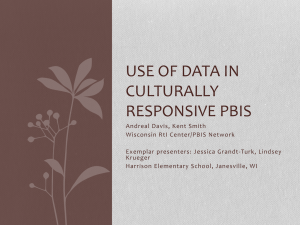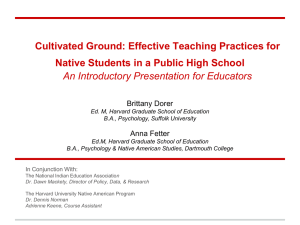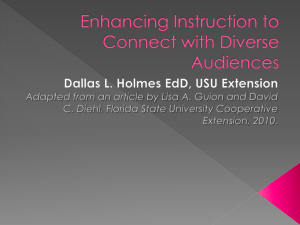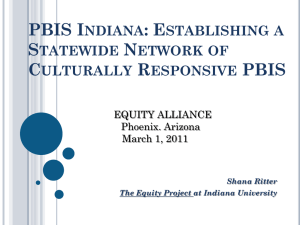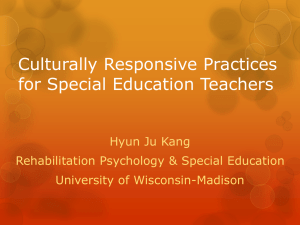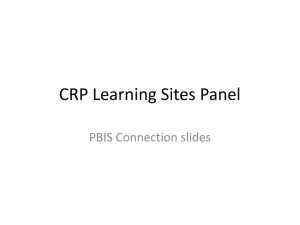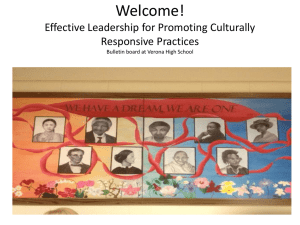PowerPoint - Wisconsin PBIS Network
advertisement
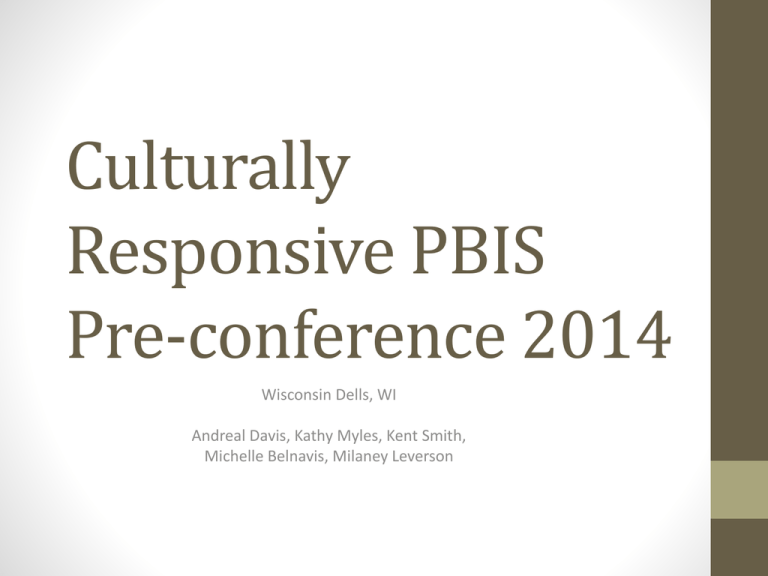
Culturally Responsive PBIS Pre-conference 2014 Wisconsin Dells, WI Andreal Davis, Kathy Myles, Kent Smith, Michelle Belnavis, Milaney Leverson Wisconsin RtI Center Our vision is that every Wisconsin school has a culturally responsive multi-level system of support that ensures fidelity and sustainability for students to achieve academic and behavioral success. Our mission is to support Wisconsin schools in the implementation of culturally responsive multi-level systems of support for all students. Materials • Presentation Power-point, activities and other resources referenced in session can be found at • http://tinyurl.com/kgcwbuh • Or by scanning: Agenda • Setting the Stage: What is the purpose behind this work? • Use of data to identify needs and PD focus • Culturally Responsive Practices • Begin to Incorporate CRP into PBIS Framework • Wrap up and work/planning time True Colors Your Personal Style Part I: Describe Yourself Below are several rows of word groups. Working one row at a time, rrank each word gn o up o i t he bsxe s ui ng a “4” forrhe t go ou p ms t like you o d wn o t a “1” fhr troe wr d gou p least like you. (Scoreo w rds across.) • Take a few minutes to complete the personal profile. • (Make sure you score the columns and not the rows) Active Opportunistic Spontaneous Competitive Impetuous Impactful Realistic Open-minded Adventuresome Daring Impulsive Fun Exciting Courageous Skillful Total Orange Parental Traditional Responsible Practical Sensible Dependable Loyal Conservative Organized Concerned Procedural Cooperative Orderly Conventional Caring Total Gold Authentic Harmonious Compassionate Unique Empathetic Communicative Devoted Warm Poetic Tender Inspirational Dramatic Vivacious Affectionate Sympathetic Total Blue Part II: Your Personal Style Preferences Brightest color:_____________ _________________ My brightest color is shaded with: ______________________ And with: _______________________ Kahil, C. & Lowry, D. (2005). Follow Your True Colors to the Work You Love. True Colors, Inc. Publishing. Santa Ana, CA. Versatile Inventive Competent Curious Conceptual Knowledgeable Theoretical Seeking Ingenious Determined Complex Composed Philosophical Principled Rational Total Green Whatever you see in a child is what you will produce – “I don’t become what I think I can; I don’t become what you think I can; I become what I think YOU THINK I can.” "Educational researchers have proven time and again that culturally responsive teaching methods increase student engagement. So if our teaching is not culturally relevant, then we as educators are not relevant." - Chike Akua “Students with disabilities are almost TWICE as likely to be suspended from school as nondisabled students, with the highest rates among black children with disabilities.” NYTimes, M. Rich Aug 7 2012 National Data • 13% with disabilities are suspended from school versus 7% of students without disabilities • 1 in 4 Black K-12 students are suspended from school at least once Students with greater than one suspension per year: • 1 in 6 Black students • 1 in 13 American Indian students • 1 in 14 Latino students • 1 in 20 White students High suspension is correlated with: • Low achievement • Dropout • Juvenile incarceration Not correlated with the race of staff writing referrals. State by state data found at Dignity in Schools Campaign Fact Sheet: www.dignityinschools.org Dan Losen & Jonathan Gillespie Center for Civil Rights Remedies at UCLA – Presented by George Sugai (8/12) As a result of these trends and data… • Federal guidelines issued January 9, 2014 from the US Dept. of Education and US Dept. of Justice recommending use of PBIS and Cultural and Racial Equity to: • alter school climate, • reduce use of exclusionary practices and • decrease discipline disproportionality • Copies of Federal Guidelines and additional resources at the end of presentation Creating a common vision Why do we exist? Who are your students? How can we enhance their lives through education? What will we collectively commit to do to make that happen? Mission, vision, beliefs Cultural, linguistic, environmental Behavior, achievement, perception data System implementation of prioritized actions Adapted from Muhammad, A. (2013, August 7). The Will to Lead: Creating Healthy School Culture. Speech presented at WI RtI Center training. Madison, WI. Personal Style • How do these tendencies impact you in your work ? • In your family? Color Group Discussion • Join your color group • Discuss “What if we had a team of people who were all (orange/blue/gold/green)? What would happen? What would go well? What may not? • Then discuss “how schools are set up? For which color group?” Share specific examples. Unintentional Reinforcement of Trends • These outcomes continue because our systems are not designed to meet the needs of or examine outcomes for ALL groups of students. • Institutions and systems have not changed substantially in the last 100 years. • These outcomes are reinforced by policy at every level; Federal, State and Local. We see the world not as it is, but as we are… Students and Schools • Create mixed color groups • Using one specific example from the previous activity – differentiate it for all color groups Culture Affects How We. . . • • • • • Think Communicate Interpret the World Make Decisions Solve Problems Cultural Competence Examining the system Self Awareness Respectful curriculum Responsibility = Institution Believing students will learn Understanding world view Standing up Knowing the community Adapted from X. Liang and G. Zhang and the State of Washington Department of Public Instruction Developing Cultural Competence • Can you think of anyone that works with you, a family member, or friend that you believe is culturally competent? • Why do you think they are culturally competent? • Are you culturally competent? Why do you think so? How do you know? • What steps have you taken to improve your knowledge and understanding of your students and colleagues who are from a different racial/ethnic/cultural group from your own? Creating a common vision Why do we exist? Who are your students? How can we enhance their lives through education? What will we collectively commit to do to make that happen? Mission, vision, beliefs Cultural, linguistic, environmental Behavior, achievement, perception data System implementation of prioritized actions Adapted from Muhammad, A. (2013, August 7). The Will to Lead: Creating Healthy School Culture. Speech presented at WI RtI Center training. Madison, WI. Risk Ratio relative risk (RR) is the ratio of the probability of an event occurring (for example, developing a disease, being injured) in one group to the probability of the event occurring in a comparison group Link Risk back to Education…. In Wisconsin, it’s another story (Retrieved from DPI website, 3/31/14) 80 70 60 50 40 30 % of total enrollement 11-12 % of enrolled group with suspension 11-12 20 10 0 Risk Ratio compared to white 11-12 12 10 8 6 4 2 0 Risk Ratio compared to white 11-12 An example of Risk Ratio Risk of Getting a Speeding Ticket 5 4.5 4 3.5 3 2.5 2 1.5 1 0.5 0 Average Driver Volkswagon gti Mercedes-Benz CLS-63 Hummer Calculation • Automatic calculator available by going to: http://tinyurl.com/pb3qg74 • Risk Ratio = x ÷ y x = percent of subgroup with particular outcome _________________________________________ y = percent of majority subgroup with same outcome Example Calculations Over the past 30 days, Office Discipline Referral (ODR) data indicates: • x = 48% of Black students have received an ODR • y = 24% of White students have received an ODR % of enrolled group with ODR 60 50 40 30 % of enrolled group with ODR 20 10 0 Black White Example Calculations Continued… Risk Ratio = x ÷ y • x (48%) ÷ y (24%) = 2 Risk ±.25 difference between risk ratios indicates a need for further action 2.5 2 1.5 Risk 1 0.5 0 Black White Risk Ratio Calculator • Show slides of calculating risk ratio with the calculator Team Time: Take Action to Address Needs • Disaggregate data specific to the subgroup: 1. 2. 3. 4. What are the behaviors that are most common? When are the behaviors happening? Where are the behaviors happening? Why might they be happening (possible motivation)? • Action plan around identified areas of need: • What is the task, Who is responsible, by When will it be completed, etc. Team Time: Planning • Once data shows a pattern, teams need to consider: • • • • • • What knowledge and skills the staff need How to deliver that (short term) How to support that (long term) How to monitor the effects and impact Where resources will come from Align to blueprint Funding Visibility Political Support Policy LEADERSHIP TEAM (Coordination) Training Coaching Evaluation Local School/District Implementation Demonstrations Behavioral Content Expertise Expertise Norms/Values and their Effects • Ways to evaluate the effects of norms/values on your system: • Disaggregate Discipline data • Disaggregate Suspension data • Compute Risk Ratio: http://tinyurl.com/pb3qg74 • If negative trends are visible: • Problem solve at the SYSTEMS level (i.e. not just one classroom/teacher at a time) • What knowledge and skills the staff need • How to deliver that (short term) • How to support that (long term) • We must change the educational setting to reach all students, NOT simply expect the student to assimilate Cultural Relevancy Gloria Ladson-Billings (UW-Madison) coined the term “cultural relevancy” in 1994. It is a way of teaching that “empowers students intellectually, socially, emotionally, and politically by using culture to impart knowledge, skills, and attitudes.” Key components of Culturally Responsive Practices: • are culturally competent, know about their students’ cultural beliefs and practices; • think of all of their students as capable learners, have high expectations for them, and help the students set short and long term goals for themselves; • know each student and draw on the students’ own experiences to help them learn; • have a wide variety of teaching strategies and skills to engage the students; • can help the students deal with the inequitable treatment of students of color and other underserved populations by helping them become critically conscious and knowledgeable about the students' culture; and • can create a bridge between the students’ home and school lives while meeting district and state curricular requirements. Concept 1 • Teachers who can create a bridge between the students’ home and school lives while meeting district and state curricular requirements. Where can I… •Validate •Affirm •Build •Bridge Validate – Affirm – Build – Bridge Keeping Relationships at the Center Validating and Affirming This involves building and nurturing relationships, established through honest self-reflection and having an open mind about what factors might be contributing to a student’s success and struggles in the classroom. Concept 2 • Teachers who are culturally competent know about their students’ cultural beliefs and practices. Establishing Relationships • Know the students’ family, interests and culture. • Plan for culturally responsive teacher/student/parent opportunities for strengthening relationships • Welcome students by name as they enter the classroom. • Learn, use and display some words in students’ heritage languages. • Acknowledge all students’ comments, responses, questions and contributions by affirming, validating, probing. • Use students’ real life experiences to connect school learning to students’ lives. Read Your Heart Out – Family Engagement • Video clip https://mediaprodweb.madison.k12.wi.us/node/579-hawthorne Concept 3 • Teachers who think of all of their students as capable learners, have high expectations for them, and help the students set short and long term goals for themselves Identity Development • Does your body language, gestures and expressions convey a message that all students’ questions and opinions are important? • Do your VISUALS (bulletin boards, instructional materials etc.): • reflect the racial, ethnic and cultural backgrounds of ALL students? • Do you create class team-building opportunities that promote peer support for academic achievement? STRATEGIES TO BUILD A CULTURALLY RESPONSIVE SYSTEM OF PBIS Shawno Exemplar BEHAVIOR VIOLATION SYSTEMS Behavior Violations • Systems must have: • Clear definitions of Major versus Minor behavior • Components to ensure staff understanding of behavior violations • Initial teaching of the system • Staff fluency checks • Frequent data reviews • Ongoing professional development for all staff based on data • When those components are in place, teams must determine whether behaviors are wrong or culturally inappropriate Addressing Culturally “Inappropriate” Behaviors • Scenario: Student comes from a strong tradition of “overlap,” which is seen as interruption in the classroom. • Allow for overlap in discussion; teach class to overlap during discussion (code-switch) • Teach student not to overlap during instruction (code-switch) • Systems need to move away from punishing students who bring cultural diversity to our schools. Team Time • Look at your T chart of behaviors as it exists. • Thinking about the Norms Matrix Andreal and Michelle walked you through: • What of those behaviors are points of concern for your team either because of: • Subjectivity, lack of staff fluency, or cultural misunderstanding • Action plan system needs: who needs to do what with whom by when? Teachers who can create a bridge between the students’ home and school lives while meeting district and state curricular requirements. FAMILY ENGAGEMENT Family Engagement • Keep in mind: • Representation of community cultures • Representation of diverse family values and systems • Family representatives and family engagement opportunities can: • Ease in validating, affirming, building relationships • Enhance sense of belonging and communication Epstein’s 6 Types of Parent Engagement 1. Parenting: Helping homes support children as students 2. Communicating: Designed to facilitate communication about programs and progress 3. Volunteering: Parents as helpers and supports 4. Learning at home: How to help students with homework & other curriculum related activities, etc. 5. Decision making: Involving families in school decisions 6. Collaboration with community: Strengthen home/school/community SCHOOL-WIDE EXPECTATIONS School-wide Behavior Expectations Respectful Responsible Safe Classroom Procedures/Routines EXPECTATIONS Be Class-Wide Arrival Cooperative Learning Groups Independent Seat Work Whole Group Identify Attention Signal…….Teach, Practice, Reinforce • Listen to others • Follow • Eyes/ears on •Use kind words • Enter/exit classroom • Accept directions speaker (is this & actions Respectful •Follow adult prepared differences distancing?) • Use inside voice • Use kind words • Create for • Raise hand to directions so others may • Encourage yourself and be speak (is this learn Be Responsible Others • Wait your turn to speak (this may disengage some students unless capital taught) •Take proper care • Place materials • Use Time Wisely in correct area • Contribute of all personal • (practice ORDER) • Complete your belongings & • Begin warm-up part school promptly equipment Be Safe •Keep hands, feet • Walk & objects to self •Use all equipment & materials appropriately • Use Materials Carefully • Respect community resources proud • Be honest in your work distancing? Options?) • Contribute to learning • Be a TASK master • Use your neighbor/com munity • Follow directions • Take notes • Meet your goals • Keep hands, feet, and objects to self • Stay at seat • Keep hands, feet, and objects to self Personal Matrix • Teach behavior expectations • Have students define what those expectations would look like: • At school • At home • In the community • For example: what does it look like to be Responsible when someone is bothering you? • At school: Tell an adult • At home: Walk away (telling an adult annoys your parents) • In your neighborhood: Stand up for yourself (or get your butt kicked) Team Time • Thinking about family engagement and your school wide/classroom expectations: • How have you engaged families in your universal system to get their “voice” and to help VABB? • How have you linked your universal expectations to students’ experiences from home and community to VABB when there is a difference? • Action plan: Who needs to do what with whom by when? ACKNOWLEDGMENT & ENVIRONMENT Do your VISUALS (bulletin boards, instructional materials, etc.): • reflect the racial, ethnic and cultural backgrounds of ALL students? Establish a Positive Environment • 5:1 acknowledgement to correction rate will help build behavior fluency • Begin each class period with a celebration or affirmation (Harambee time – “come together”) • Chant, song, celebration • Builds community, belonging and group identity • Your first comment to a child establishes behavioral momentum • “Interspersed requests” • Behavioral priming • Provide multiple paths to success/praise. • Group contingencies, personal contingencies, etc. Teaching & Using Acknowledgement Acknowledgement: • Is an important part of how behaviors are taught • Builds behavioral fluency faster • Helps teach cultural capital (code switching) when cultural differences exist • Develops positive connections between student and school Positive Environment Think about whose experience is on display: • Can all students SEE themselves and their experiences on display DAILY? • What reading material is available and who is shown in it? • What music is used? What art is shown? What history is taught? Review range of instructional and work options: • How are students expected to complete work (in a small group, individually, etc.)? • What type of instruction is provided (lecture, call and respond, movement based)? Team Time • Considering the last points, audit your school wide and known classrooms for these points: • Can ALL students see/experience their culture in these settings DAILY? • Are all student cultures part of the daily experience in the setting and material? • Action plan: If student experiences are missing, how will you address this? What do staff need to be taught, what is your plan? Conclusion • Reducing disparate impact is the responsibility of the SYSTEM that the school is based on. • To be successful, the SYSTEM has to evaluate its progress and address needs on a regular basis. • Family and community resources can be used to help provide necessary professional development. Conclusion • System change needs to occur at the staff level daily in the classroom. • BUT it also must be driven from the administrative level in terms of system mission. • “Culture eats structure for breakfast.” • If the system does not change, the individual efforts will have limited impact. Wrap up • Objectives for this session included: • Define CRP and how it fits with PBIS • Offer practical short term ideas to start the conversation with staff • Guide how to start long term professional development (resource section) Remaining Time • Remaining time is yours to finish action planning how you will take and use this information to change your systems. • Long term – What is your larger vision of what you want to be different in your building and how will you get there via short term goals. • Short term – what are things you can do in the next year that will have some impact and lead to larger changes. Contact info: Andreal Davis – Culturally Responsive Practices Coordinator davisa@wisconsinrticenter.org Kathy Myles – Coaching and Leadership TAC mylesk@wisconsinrticenter.org Kent Smith – PBIS TAC smithk@wisconsinpbisnetwork.org Michelle Belnavis – Culturally Responsive Practices TAC belnavism@wisconsinrticenter.org Milaney Leverson – PBIS TAC leversonm@wisconsinpbisnetwork.org

